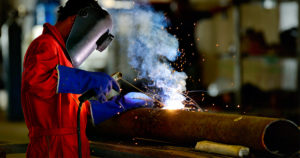Protecting Welders from Job-Related Dangers
January 29, 2021 According to the Occupational Safety and Health Administration (OSHA), there are numerous hazards associated with welding, cutting, and brazing operations. Welders are skilled workers who fabricate and put together metal parts. While their skills can be in high demand, they also face an array of jobsite dangers, such as exposure to metal fumes and gases, ultraviolet (UV) radiation, and safety hazards from using industrial machinery. Overexposure to controllable hazards can cause short or long-term health complications in employees, which is why employers must uphold their legal obligation to protect workers from known occupational hazards and to provide safe and healthful workplaces.
According to the Occupational Safety and Health Administration (OSHA), there are numerous hazards associated with welding, cutting, and brazing operations. Welders are skilled workers who fabricate and put together metal parts. While their skills can be in high demand, they also face an array of jobsite dangers, such as exposure to metal fumes and gases, ultraviolet (UV) radiation, and safety hazards from using industrial machinery. Overexposure to controllable hazards can cause short or long-term health complications in employees, which is why employers must uphold their legal obligation to protect workers from known occupational hazards and to provide safe and healthful workplaces.
Welding Hazards
Metal work is an integral part of many different industries like construction, energy extraction, and automotive manufacturing. Welding can generally be broken down into two groups: fusion welding and pressure welding. Both of these processes join metals (and sometimes thermoplastics) together by using a heat source to create fusion between the parts while they cool. The main difference between pressure welding and fusion welding is that pressure welding uses pressure and heat whereas fusion welding uses heat alone. Regardless of whether they are pressure or fusion welding, all welders are exposed to extremely high levels of heat while they work.
Heat exposure is by no means the only job-related hazard that welders face. Other common occupational hazards include:
- Electric shock, which is one of the deadliest risks that a welder can encounter. Welders are vulnerable to experiencing electric shock when they touch two pieces of metal that are electrically charged by a voltage running between them, thereby inserting themselves into the electrical current. Arc welding circuits, for example, have somewhere between 20 and 100 volts of electrical current – a shock from just 50 volts can cause deadly injuries to circuit operators.
- Welding fumes and gases. Welding fumes typically contain a mix of metal oxide compounds like carbon monoxide, carbon dioxide, argon, nitrogen, and hydrogen fluoride, as well as metals like lead, aluminum, arsenic, beryllium, and manganese. All of these compounds and metals can be hazardous to a person’s health if breathed in. According to OSHA, short-term exposure can result in eye, nose, or throat irritation, nausea, and dizziness. Long-term exposure can lead to nervous system and kidney damage in addition to cancer of the urinary tract, larynx, and lungs.
- Injuries resulting from insufficient PPE, or personal protective equipment. Welding PPE should provide comprehensive protection from burns and other hazardous exposures while still allowing for physical movement. Welders should have eye and face protection (like helmets, hand shields, and/or goggles), respirators to protect against the inhalation of fumes and gases, fire and flame resistant clothing or aprons, foot and hand protection like gloves and rubber-soled safety shoes, and hearing protection such as earmuffs or ear plugs.
- Fires and explosions. The welding arc, which is an electric arc that puts off heat to fuse metals together, can reach temperatures around 10,000 degrees Fahrenheit. Fire and explosion dangers stem from the high level of heat that the welding arc expels into its surrounding area as well as any sparks or spatter that it releases. Flammable items that are close to the welding arc may catch fire and if a welder does not have adequate PPE, his or her clothing could ignite as well
Employers are legally obligated to comply with federal safety and health standards in order to protect workers from known hazards. Most accidents and injuries that happen on the job are preventable, but not if a company fails to prioritize the wellbeing of their employees. Known control methods for reducing welding-related hazards, for example, include removing flammable items from welding arc areas, ensuring that workplaces are adequately ventilated to reduce inhalant exposure risks, providing metal workers with effective and industry-standard personal protective equipment, and providing comprehensive safety trainings on using equipment and recognizing hazards. It is also critical to conduct routine inspections on all welding machinery and equipment in order to ensure that it is in proper working order and is not damaged.
Injured at Work?
When a worker is injured due to preventable jobsite safety and health failures, he or she can file a workers’ compensation claim. Workers’ compensation is a type of insurance that provides wage replacement and medical benefits to injured workers. If you would like to learn more about filing a workers’ compensation claim, someone at our firm can help. Contact a representative online now.
Philadelphia Workers’ Compensation Lawyers at Galfand Berger, LLP Representing Injured Workers Since 1947
Galfand Berger LLP has offices located in Philadelphia, Bethlehem, Reading and Lancaster, we serve clients throughout Pennsylvania and New Jersey. To schedule a consultation, call us at 800-222-8792 or complete our online contact form.
 Google Screened
Google Screened
